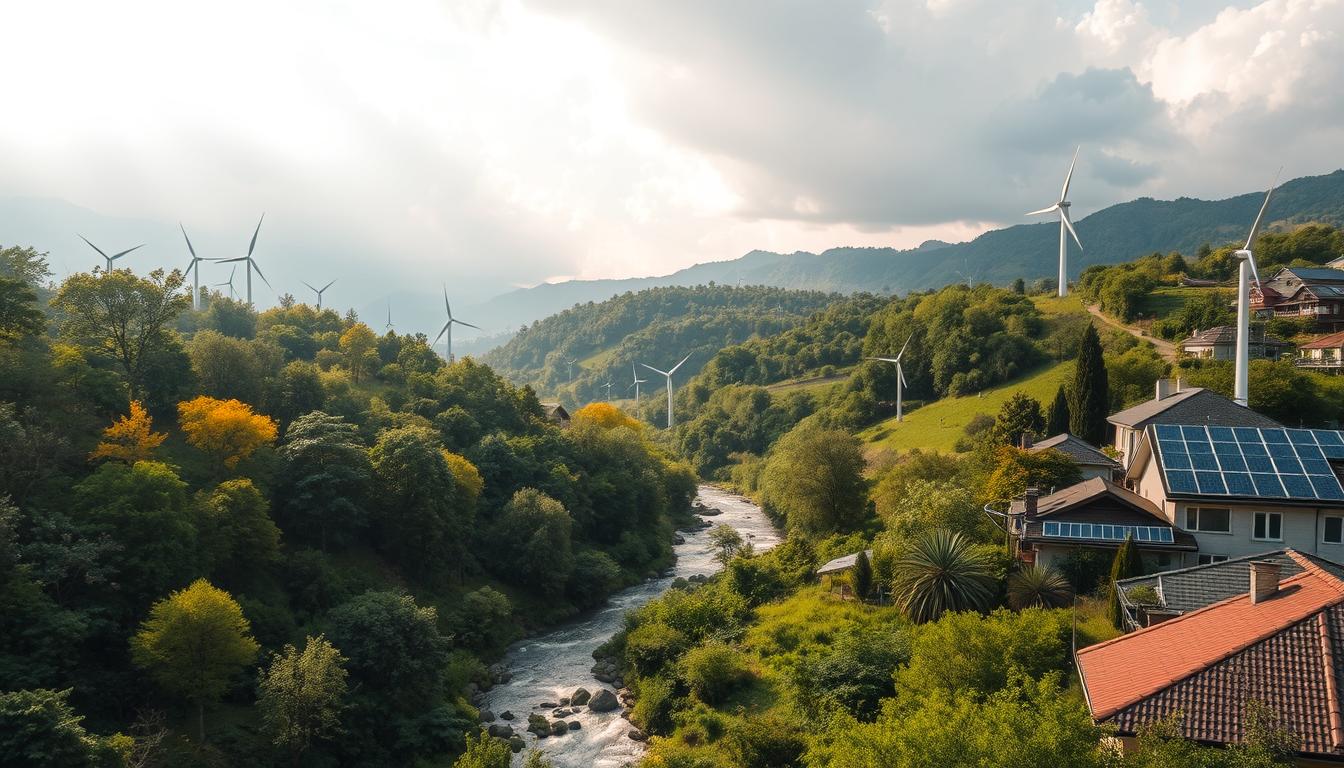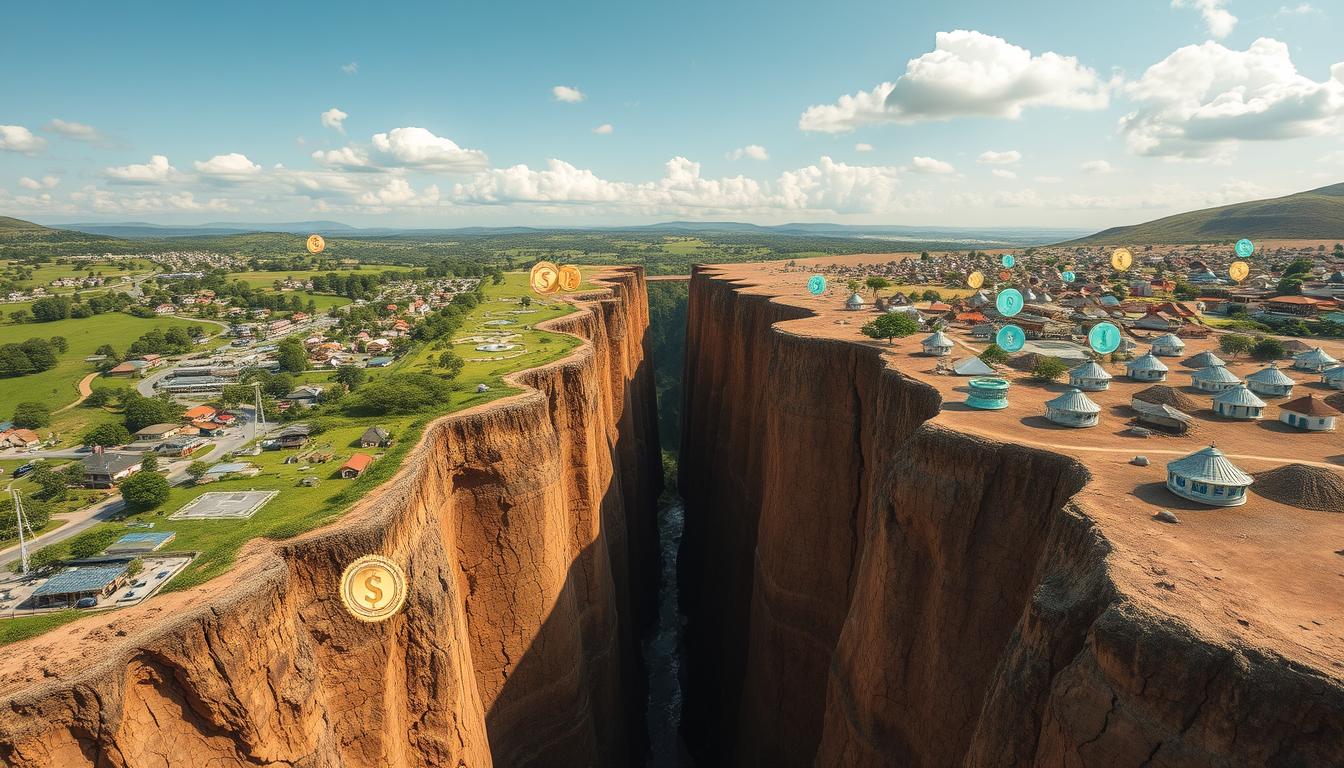Funding Our Future Adaptation Financing | Learn More
The climate crisis is getting worse fast. Countries in Asia and Africa are hit hard. In 2023, floods and storms in Asia affected over nine million people. Climate disasters also cut Africa’s GDP by 2-5% every year.
Adapting to climate change will cost $215 billion annually for the next decade in developing countries. But, they need $387 billion every year to adapt. This shows how urgent it is to get more funding for climate adaptation.
Key Takeaways
- The climate crisis has escalated, with developing countries in Asia and Africa bearing the brunt of weather-related hazards and economic impacts.
- Adaptation financing is lagging behind development and transition finance, with a projected annual cost of $215 billion for adaptation in developing countries.
- The total finance needed to meet domestic adaptation needs in developing countries is estimated at $387 billion per year.
- Securing adequate and sustained funding for climate adaptation efforts is crucial to address the growing challenges.
- Innovative financing solutions and increased private sector engagement are necessary to bridge the adaptation finance gap.
Understanding the Global Adaptation Finance Crisis
The world is facing a big problem with adaptation finance. The money we have for climate adaptation is much less than what we need. Countries need about $215 billion every year for the next ten years to adapt to climate change.
But, in 2022, we only got $28 billion for adaptation. This is a tiny part of what we need.
Current State of Climate Adaptation Needs
Even though we’ve made some progress, we still have a big gap in adaptation finance. Most countries have plans for adapting to climate change. But, we’re not doing enough because we don’t have enough money.
Right now, we only have 13% of the money we need to tackle the biggest adaptation challenges.
Key Challenges in Developing Countries
Developing countries, especially small island states, need the most help. They face huge challenges from climate change. For example, Dominica needs 50 early warning systems to protect its people. But, they’ve only set up three so far because they don’t have enough money.
Impact of Weather-Related Hazards
Weather-related hazards like floods, droughts, and heatwaves are making things worse. These events cause damage and need long-term solutions. Without enough money, countries can’t keep up with climate change.
The adaptation finance crisis is a big problem that needs everyone’s help. By understanding the needs, challenges, and impacts, we can find ways to solve it. We need to work together to create climate adaptation strategies and green finance initiatives. This will help us close the adaptation financing mechanisms gap and make a more resilient future.
The Growing Adaptation Finance Gap
Climate change is hitting us hard, making it crucial to fund climate resilience. But, the numbers are scary. In 2021, funding for adaptation in developing countries fell by 15%, to just US$21 billion. The gap is huge, at US$194-366 billion each year.
The private sector gave only US$2 billion in 2022, just 2% of all environmental funding. Adaptation projects find it hard to get money because they take longer to show results. There’s also no clear way to track climate adaptation, making it tough to get the funds needed.
| Metric | Value |
|---|---|
| Adaptation finance gap per year | US$194-366 billion |
| Private sector contribution in 2022 | US$2 billion (2% of tracked adaptation finance) |
| Adaptation finance to developing countries in 2021 | US$21 billion (15% drop from previous year) |
| Goal to double adaptation finance by 2025 | Would only reduce the gap by 5% |
Bad governance can also waste funds, making things worse. To fix this, we need new financial ideas, better partnerships, and a global push for green financing for adaptation.
Funding Our Future Adaptation Financing
The world faces growing climate change impacts, making adaptation financing mechanisms crucial. Two-thirds of needed adaptation funds will come from the public sector. Yet, most public funds are non-concessional loans, with only a quarter being concessional.
Public Sector Funding Mechanisms
Governments and international bodies are key in funding climate adaptation. The Adaptation Fund has given over $1 billion to adaptation projects since 2010. It supports National Implementing Entities (NIEs) and funds innovation and project growth.
Private Investment Opportunities
The private sector can also help fill the adaptation finance gap. New financial tools, like performance-based sustainability-linked bonds, attract private money. Nature-based solutions are also appealing to businesses and investors for their cost-effectiveness and sustainability.
Innovative Financial Solutions
To boost adaptation financing mechanisms, we need a variety of approaches. We should increase grant and concessional finance, develop climate risk frameworks, and encourage green finance initiatives. These steps will draw the private sector into climate resilience efforts.
| Funding Source | Contribution to Adaptation Finance | Key Initiatives |
|---|---|---|
| Public Sector | Estimated to meet two-thirds of adaptation financing needs |
|
| Private Sector | Emerging opportunities for sustainable investments |
|
| Innovative Solutions | Expanding adaptation financing mechanisms |
|
By using public sector funding mechanisms, private investment opportunities, and innovative financial solutions, we can secure the funds needed for a climate-resilient future.
International Climate Finance Institutions and Reform
The world faces growing climate change impacts, making climate finance more urgent than ever. Multilateral financial institutions, like MDBs and climate funds, are key in providing green financing. They need to change to better serve the needs of funding our future adaptation financing.
MDBs aim to reach $120 billion in climate finance by 2030, with $42 billion for adaptation. The Bridgetown Initiative proposes more funding and concessional lending for developing nations. Debt relief could help nations use more resources for adaptation investments.
The International Finance Corporation is looking into new ways to boost private sector investment in adaptation. The World Bank Group’s Spring Meeting in April 2025 will be crucial for these reforms. It will bring together stakeholders to improve the global climate finance landscape.
The world is facing more climate change impacts, making climate finance more urgent. Multilateral financial institutions, like MDBs and climate funds, are key in providing green financing. They need to change to better serve the needs of funding our future adaptation financing.
Building Climate Resilient Investment Frameworks
Nations face big challenges from climate change. They need strong climate adaptation strategies. It’s key to add climate goals to national plans and budgets.
National Adaptation Planning
Governments must put climate goals in their national plans. This means working with many groups to get different views. Also, they need to check and choose projects that make things more resilient.
Project Pipeline Development
Using smart planning can create a list of projects ready for funding. Working with private groups and finding new ways to pay for things can help. This way, countries can get the money needed for big changes.
Risk Assessment Strategies
Knowing the risks from climate change is key. Strong risk plans, like the UAE’s, help make sure all areas are ready. This guides where to invest and keeps projects going.
The world will meet in June 2025 to talk about money for development. This is a chance to make climate adaptation a big part of the discussion. Getting finance leaders on board and linking adaptation with development goals is crucial. It’s how we’ll get the money to make communities strong against climate change.
“Investing in climate adaptation is not only a moral imperative but also an economic necessity. By building resilient infrastructure and empowering communities, we can safeguard our shared future and unlock new opportunities for sustainable growth.”
| Adaptation Strategies | Key Benefits |
|---|---|
| Nature-based Solutions | Enhance ecosystem services, improve biodiversity, and provide cost-effective protection against climate-related hazards. |
| Climate-resilient Infrastructure | Ensure critical systems and services can withstand the impacts of climate change, reducing disruption and economic losses. |
| Early Warning Systems | Provide timely information to communities, enabling effective preparedness and emergency response measures. |
Conclusion
Scaling up adaptation financing is key to tackling the climate crisis and helping vulnerable communities. The New Collective Quantified Goal (NCQG) at COP29 is a big moment. It will shape future climate finance, including a focus on adaptation.
The Adaptation Fund hopes to raise $300 million at COP29. This will help fund its projects. Also, the International Development Association meeting in December is a chance to get more funding for climate adaptation.
Mainstreaming adaptation finance in development plans is becoming more common. It shows how climate impacts and sustainable development are linked. If we don’t act fast, the costs will be higher for communities.
We need to work together to close the adaptation finance gap. This gap is between $194 billion and $366 billion yearly. Funding climate adaptation, improving climate data, and setting up early warning systems are crucial. These steps will protect vulnerable communities and ensure a sustainable future.
FAQ
What is the current state of climate adaptation needs globally?
The climate crisis is now a reality that demands urgent action. Developing countries face severe climate risks. In Asia, over 80% of weather-related hazards in 2023 were floods and storms, affecting more than nine million people. In Africa, climate-related disasters annually diminish GDP by 2-5%.
Adaptation finance is much less than development and transition finance. The cost of adaptation in developing countries is estimated at US$215 billion annually for this decade. The finance needed to meet domestic adaptation needs stands at US$387 billion per year.
What are the key challenges in developing countries regarding adaptation finance?
Adaptation needs are not being met worldwide. Developing countries need $215 billion per year for the next decade for adaptation priorities. International finance flows for adaptation were just $28 billion in 2022, far short of the need.
87% of countries have at least one national adaptation planning instrument, up from 50% a decade ago. However, there’s a growing gap in implementation due to lack of finance. Small island states urgently need support to strengthen resilience.
For example, Dominica needs 50 early warning systems but has only installed three by 2023.
What is the current adaptation finance gap and its impact?
Public, multilateral, and bilateral adaptation finance to developing countries dropped by 15% in 2021, reaching just US$21 billion. The current adaptation finance gap is estimated at US$194-366 billion per year. Private sector contribution was only US$2 billion in 2022, representing 2% of tracked adaptation finance.
Adaptation projects struggle to secure financing compared to mitigation projects. This is due to longer timeframes for benefits and less clear returns on investment. The absence of a clear taxonomy for climate adaptation adds to uncertainty. Weak governance standards can lead to misallocation of funds towards personal interests and maladaptation.




